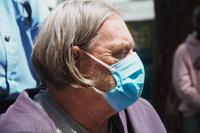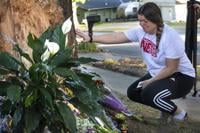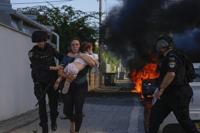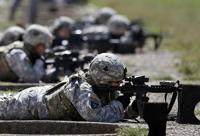BOSTON (AP) — A highly anticipated trial began in Massachusetts this week involving a woman accused of striking her Boston police officer boyfriend with her SUV and leaving him for dead in a snowbank.
John O’Keefe died in the Boston suburb of Canton on Jan. 29, 2022.
The case has garnered national attention because the defense alleges that state and local law enforcement officials framed Karen Read and allowed the real killer to go free.
A look at the facts and legal arguments:
THE CHARGES: A TUMULTUOUS RELATIONSHIP TURNS DEADLY
Karen Read, 44, of Mansfield, Massachusetts, , including second-degree murder, in the death of John O’Keefe, 46. The 16-year police veteran was found unresponsive outside the home of a fellow Boston police officer.
After a night out drinking at several bars, prosecutors say Read dropped O'Keefe off at a house party just after midnight. As she made a three-point turn, prosecutors say, she struck O'Keefe before driving away. She returned hours later to find him in a snowbank.
Prosecutors are trying to show that Read's actions were intentional. To do that, Norfolk Assistant District Attorney Adam Lally offered what he said was evidence that the couple's stormy relationship had begun to “sour” in the month before O'Keefe died. The prosecution's first witness, O'Keefe's brother Paul, testified that the couple regularly argued over such matters as what Read fed O'Keefe's two adopted children, and that he witnessed a 2021 fight the couple had in Cape Cod over how O'Keefe treated her.
Paul O'Keefe's wife, Erin, testified that Read told her the couple fought in Aruba after she caught O'Keefe kissing another woman.
THE DEFENSE: POLICE ARE FRAMING THE SUSPECT
In their opening statement, the defense team portrayed the investigation into O'Keefe's death as shoddy and undermined by the close relationship investigators had with the police and other law enforcement agents at the house party.
They argued that investigators focused on Read because she was a “convenient outsider” who saved them from having to consider other suspects. They plan to argue that someone other than Read was responsible for O'Keefe's death, and have floated the theory that he was beaten inside the house and left for dead outside.
Defense attorneys also criticized investigators for failing to search the house where the party was held to see if a fight had occurred. They contend that O'Keefe's injuries were consistent with being beaten up.
On Friday, defense attorney Alan Jackson attempted to show a connection between first responders on the scene and the owners of the house where O'Keefe died. Jackson repeatedly questioned Katie McLaughlin, a firefighter who responded to the scene, about her relationship with Caitlin Albert, whose family lived there at the time of O'Keefe's death.
McLaughlin confirmed that she and Caitlin Albert went to high school together, were friends on social media and were photographed together at a local beach. But she insisted they were only acquaintances and that she didn't know it was Albert's home when she responded to the call. She also said she hadn't talked to Albert for a few years.
THE SCENE: DISTRAUGHT READ, SCREAMING IN A SNOWSTORM
Prosecutors appeared early on to be relying on Read's own . Most of the first week has been dominated by first responders, who detailed a harrowing scene that morning in January 2022.
They came upon O'Keefe lying face-up and Read, distraught and screaming near the body, appearing to have blood on her mouth from giving CPR.
The most incriminating testimony this week came from several first responders who recalled Read telling them loudly and repeatedly that she “hit him,” though she never said it was with her SUV.
Another witness, a police officer who was among the first on the scene, testified that Read said O'Keefe's death was her fault, though she didn't say how she was responsible.
THE EVIDENCE: ARE THERE INCONSISTENCIES?
The defense has worked to undermine the credibility of the first responders testifying for the prosecution. They pointed out mistakes on a police dispatch log, including the wrong address for where O’Keefe’s body was found.
They also got one witness who testified that he heard Read say O’Keefe’s death was her fault to acknowledge that he never wrote that in a police report; suggested another witness may have been too focused on saving O'Keefe's life to be able to hear Read say she hit O'Keefe;. and showed a video from the scene suggesting that one of the first responders who claimed Read told him she hit O'Keefe didn't even talk to her.
In addition, they tried to plant doubts in the jury's mind about the overall investigation, getting several witnesses to say they never heard Read say she hit O'Keefe, or saw dozens of pieces of broken taillight at the scene, evidence that prosecutors say shows she backed into him.
Jackson also sparred with McLaughlin on Friday over what he described as her “evolving testimony,” a suggestion that she has changed her story over time. On Thursday, McLaughlin said Read told her repeatedly that she hit O'Keefe. On Friday, however, Jackson noted that she had told state police a day after O'Keefe's death that Read made those comments to another woman at the scene. McLaughlin initially pushed back, saying her testimony had been “pretty consistent," before then acknowledging that it had changed.
THE VICTIM: HOW DID HE DIE AND WHEN?
The trial's first few days detailed the futile efforts of first responders to save O'Keefe. They found him face-up when they arrived just before dawn on Jan. 29.
One witness testified that O'Keefe wasn't breathing and didn't have a pulse. Another said his body temperature was only 80 degrees Fahrenheit (26.6 Celsius), which he described as extreme hypothermia.
O’Keefe's condition never changed, despite first responders’ efforts to save him. He was pronounced dead at a hospital. An autopsy found he died of hypothermia and blunt-force trauma.








































